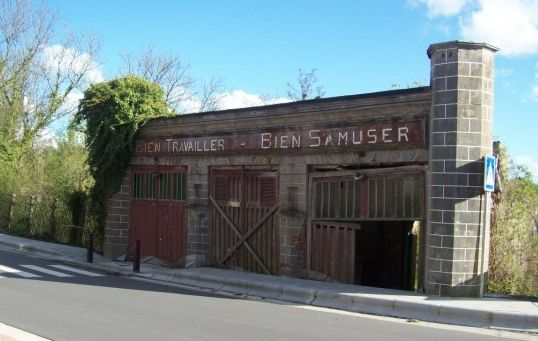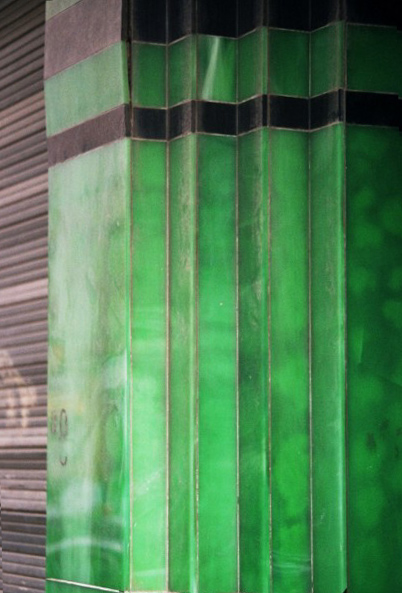|
|
The factory sites at Fauquez and Braine le Comte (Hainaut, BE) have long since fallen derelict, and only the front of the building has been preserved, but once it was the workplace for more than 800 glassworkers.
 © Bernard Delnatte; http://baladescentre.skynetblogs.be/ © Bernard Delnatte; http://baladescentre.skynetblogs.be/In 1899, Émile Michotte, a glassworker from Manage, purchased the old paper mill of Fauquez, founded in 1836, and transformed it into a tumbler factory, increased and renamed in 1901 S.A. des Verreries de Fauquez. In 1904, Arthur Brancart (1870-1934) was appointed technical manager of the factory. The 1920s were the golden age of Fauquez, with the invention of Marbrite. The main factory was dedicated for many years to the production of Marbrite (1919), a fire-polished decorative tile which was mostly used to highlight the exterior of buildings, and for feature-tiling in bathrooms and lobby areas. Made from an opaque glass which resembled marble, the technique used cold-rollers bearing a regular pattern which caused the surface of the glass sheet to cool more quickly, and resulting in a 'controlled cloudiness'. Consistent in quality and available in bright colours, Marbrite was shown in Paris (1925) and is well-recognised and well-documented in the literature of art-deco architecture, especially in Belgium, competing for the European market against Pilkington(UK) and Chodau(CZ).  Marbrite in Art Deco Building The sudden and short-lived wealth which Marbrite created for the town was used for public benefit by socialist industrialist Arthur Brancart. A member of the POB (Belgian Workers Party) he established an industrial-socialist community. Immigrant families who worked there were welcomed with free accomodation and good salaries. Brancart had a large part of the village redeveloped, as well as the school, the cinema, the village hall, the shops and last but not least the glass chapel (see below). After the war the buisiness was run by Brancart's sons Robert, Yvon, Robert and Raoul and his nephew Claude Locreille, but the market was fading and Marbrite production was stopped finally in 1964, with production of blown glass finally finishing in 1974. |

 Amongst the surviving monuments to the Fauquez factory, The Chapel of Glass shows the effect of Marbrite on a grand scale. In 1929, Brancart built the St. Lutgarde chapel, aka the Glass Chapel, to demonstrate the use of a modern product (Marbrite) in a traditional building. The interior and the exterior of the chapel were both completely covered with the local brand of opaque glass. Until 1977 it was used for church services and sometimes as exhibition space, until being purchased in 1990 by Michaël Bonnet, who saved it from destruction. Today it is used as a home, as a performance hall, as a memorial to the industrial patrimony, and also contains a Breton crêperie. The factory's monument to its dead in World War 1, which still stands in the centre of the town, also features a discrete border of Marbrite tiles. 
The Glass Chapel, Braine Le Comte
can be opened to visitors by appointment and contains a small exhibition of the products which were made at the Fauquez factory |
|
|